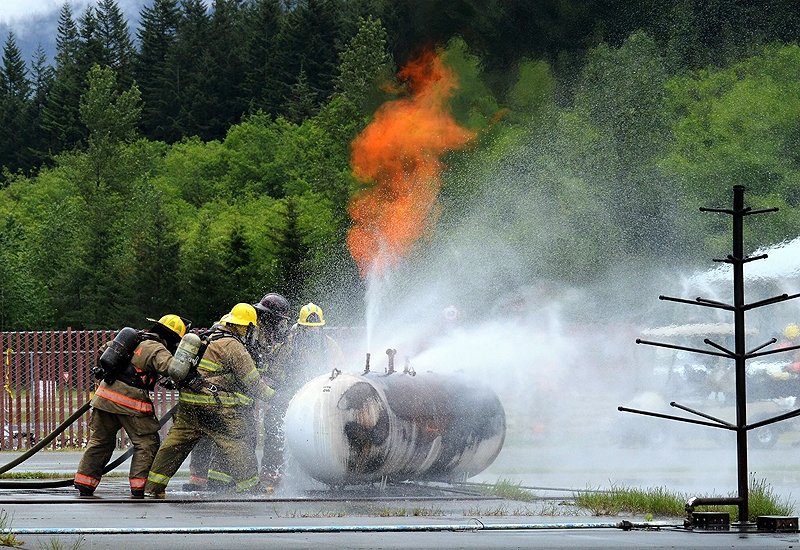 KP firefighters routinely train to extinguish propane-fueled fires likely to start after a major earthquake. Photo by Anne Nesbit.
KP firefighters routinely train to extinguish propane-fueled fires likely to start after a major earthquake. Photo by Anne Nesbit.
In early June, Key Peninsula Fire District 16 participated in the first-of-its-kind Federal Emergency Management Agency (FEMA) Cascadia Rising 2016 Catastrophic Earthquake and Tsunami Disaster Exercise. The regional exercises simulated a disaster scenario of a 9.0-magnitude earthquake lasting four minutes. The huge, multiagency drill was created by FEMA to assess and develop strategies for responding to a massive earthquake along the 800-mile long Cascadia Subduction Zone.
"With an event of this size, we could safely assume the Narrows Bridge will at the very least be temporarily out of use, cutting us off from the rest of Pierce County," said KP Assistant Fire Chief Hal Wolverton.
"At the station level, our drill began at 8 a.m. with four minutes of shaking," Wolverton said. "First order was to assess the stations and report to the Gig Harbor Multiagency Communications Center and the Pierce County Department of Emergency Management. What if our Communications 700 Digital systems are down? What if we can’t resort to personal cell phones? During the exercises, we trained with local ham radio operators, who provide vital communication when all else fails. This whole exercise was about coordinating our local efforts, working together with whatever resources we have left.
"We realized our public schools regularly hold earthquake-emergency drills, which instruct the standard response: Call 911. What if 911 no longer exists?" Wolverton asked. "We are likely to be on our own for multiple days, potentially weeks following a catastrophic earthquake, and preparation is critical."
Firefighters also began considering just how long they could potentially be away from their own families and homes if they happened to be on shift during such an event. "We’re thinking on a scale we don’t normally ponder," Wolverton said.
"Our group chose to put aside the bigger what-ifs and focus on what we can do in-house. We recognized we ourselves weren’t well prepared with emergency food and water for shifts lasting much over three days. Food, water, fuel, communications are all essential resources to enable us to help others," he said.
In contemplating a disaster of this magnitude, Wolverton encouraged KP residents to ask themselves: "Would I have enough food and water to last longer than three days, perhaps even weeks? Am I well enough prepared to take care of myself, so I can be of service to others in a disaster?" When the big one comes, it’s likely to be down to neighbors taking care of neighbors for what could be a very long time, he said.
UNDERWRITTEN BY THE FUND FOR NONPROFIT NEWS (NEWSMATCH) AT THE MIAMI FOUNDATION, THE ANGEL GUILD, ADVERTISERS, DONORS AND PEOPLE WHO SUPPORT INDEPENDENT, NONPROFIT LOCAL NEWS